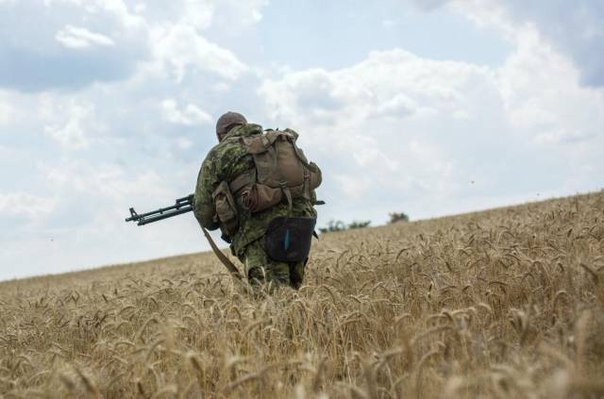
Concise and easy, catchy and visible from far away, the insignia of the Russian soldiers of the twentieth century known worldwide. Red Star has become as famous a symbol of victory in the Great Patriotic War, as the T-34 or attack «IL-2», and in the same universally recognizable symbol of post-war Soviet power, as a Kalashnikov or MiG-21.
The history of Red Star, it would seem, is inseparable from the history of Soviet Russia. After all, it started to use almost immediately after the October Bolshevik revolution, and finished shortly after the collapse of the Soviet Union. But in reality, military history «Mars Star», how else to call it a sign, in Russia, a little earlier start.
When I completed the October revolution, and before the Bolshevik power was a question of the armed defense of their gains, the only real military power, on which they can rely on, Red Guard detachments were. These heterogeneous formation, It has become the main striking force in St. Petersburg and Moscow, They consisted mainly of workers and the most conscientious soldiers, left their parts, not for escape from war, and with the idea, that life in the country really needs a major shake-up.
But in the beginning of the civil war the armed forces of the new government were forced to use the same weapon, based on the same field manuals and dressed in the same uniforms, that of their opponent. The only way to distinguish friend from foe become specific signs. The Red, as expected, bet on red, long and firmly associated with the revolutionary movement in Russia. Initially treated with red armbands and red stripes on their caps and hats. But by December 1917 , in Petrograd Red Guards, as the most organized of all such units, We decided to, that they need a more comfortable and not so easily counterfeited mark.
They are something and become a red star, which 15 December 1917 year its order imposed in Petrograd Red Guard commander of the Petrograd Military District Konstantin Eremeev. And after five days, 20 December, new logo discuss the main headquarters of the Red Guard of Petrograd and encouraged to use it throughout the revolutionary military units — as the existing, and emerging.
but suppose, if it was the Petrograd Red Guards were the inventors stars, wrong. As it is the military symbol, designating, true, not so much the nationality of the military units, as commander of the rank of, five-pointed star appeared on the uniforms of the French Republican army during the French Revolution. Then they can be seen on the headdresses, epaulettes, scarves, on the coattails of the uniform. A little bit later, in the Grand Army of Napoleon I, Stars were only on the general's epaulettes. apparently, From there, they in January 1827 command, the All-Russian Emperor Nicholas I, — a great admirer of Napoleon's army — and moved to the epaulettes of Russian officers and generals. The size was the same stars, and rank category determined by the presence or absence of a fringe and its thickness. And when 1854 epaulettes year began to take positions shoulder straps, then on them the title is still determined by asterisks and is still the same size: rank category denote the number and presence of gaps.
Almost at the same time, but in a different side of Europe — covered in revolutionary fire Garibaldi Italy — first appears and the red star as a symbol of the revolutionary army. AT 1849 was put on the peak of a five-pointed red sign began to wear on a par with a banner in front of the columns supporters of Giuseppe Garibaldi. Given the popularity of this revolutionary in Russia, easy to assume, and that it was known for certain symbols domestic socialists and other subversives monarchy.
Finally, on the idea of using the star as a military identification mark Bolsheviks could touch up their predecessors of the Provisional Government. known, what 21 April 1917 the military and naval minister Alexander Guchkov its order №150 introduced a new badge for sailors: socket with anchor, on which it was placed a star.
So the star as a symbol of the military was to 1917 It was already well known in Russia — and could only decide, how to turn it into a symbol of the new, revolutionary workers 'and peasants' army. The answer was obvious: make it red, as well as all previous decals Red.
The first official sketch of a red star in the Red Army as a mark was approved in the spring 1918 of the year. 19 April newspaper «Proceedings of the All-Russian Central Executive Committee of Soviets of Peasants', working, Soldiers 'and Cossacks' Deputies» there was a correspondence, which it said, that's Commissariat for Military Affairs approved badge drawing for Red Army soldiers in the form of a red star with a golden image of the plow and the hammer in the center. By itself, the star, which, by the way, and Article, and for some time after the official adoption was called «Mars star», personified, one side, god of war Mars, with another, due to its red color — revolution protection. And the symbolism of the hammer and plow was read and that is easier: they, of course, personalize «Workers' and Peasants» the nature of the new army.
Interesting, that one of the preliminary sketches, painted and the proposed commissioner of the Moscow military district Nikolai Polyansky, except for the plow and the hammer, attended also book — as a symbol of the intelligentsia. But the book refused, considering, it overloads the mark and makes it difficult to read. In itself the idea to combine in one symbol character of the workers and peasants was first implemented in March 1917 of the year, when the banner of the Moscow factory workers Faberge image appeared crossed hammer, plow and rifle.
With the approval of the order of the number of Narkomvoena 321 from 7 May 1918 , a new sign of the Red Army was called «Mars star with hammer and plow» and was worn on the left chest. by the way, many Red Army, especially red commanders, We chose to wear a badge on his belt — that it does not cling to him, and did not close, turning red warrior in an unknown armed man. And this consideration in July 1918 year forced the Revolutionary Military Council of the republic to give the order to move the red star with the chest band on the cap — a place, which has become familiar to several generations of Soviet soldiers. A 15 November of the same year there was an order number RVS 773, that the red star was finally placed on the headgear, and not only the Red Army, but the Red Fleet.
The first enamel red star, name «crow's nest», It had a characteristic shape. Its rays were thicker, than we're used to seeing, and their faces are slightly convex, why all star seemed more volume. In this form, — with convex thick rays, hammer and plow — it lasted four years. 13 April 1922 , the plow, which is considered a symbol of the prosperous peasantry, ie fists, replaced the sickle for poor (although, Most likely, in this change was more mundane design explanations: sickle depicted easier and more easily comprehended). In three months, 11 July, We changed the shape of the star — they straightened, giving a sign familiar to us kind of.
Very soon, the symbol of the Red Army — main power, aimed at protecting the world's first state of workers and peasants — It began and its defenders, and their opponents to personify itself and Soviet Russia. So there is nothing surprising in the fact, what in 1923 , the red star, but without the hammer and sickle, that is, in the most general form, It appeared as the closing element on the emblem of the USSR. A year later, there was a red star on the flag of the USSR, at 1928 she became familiar oktyabryatskoy organization (instead of a hammer and sickle on it placed the image of the young Volodya Ulyanov), and in 1942 — and pioneering icon.
As for the Red Army, then it was a red star is not only the hallmark of, which was placed on the headgear — caps, pilotkah, helmets and shlemah-«budenovkah», but part Patches differences. FROM 1919 by 1924 year red star wore on the sleeves of the Red Army, separated from the command and ending with the front commander. After 1924 year red stars remained only on the lapels commanders youngest category — K-1 (level commanders and divisions in the Army and Air Force junior minders), then 1940 it — only senior officers, since Major General. Sailors RKKF red stars on the cuffs of sleeves retained much longer: to 1991 of the year, gradually replaced for gold at all ranks, except admiral.
true, at 1969 year armbands stars back in the Soviet Army — but not in the form of decals, and the arm-like member stripes, points to the genus or species troops, which is their owner. Notably, that such patches worn only by conscripts and extended service and cadets of military schools — Officers do without them.
Julia Kunin











